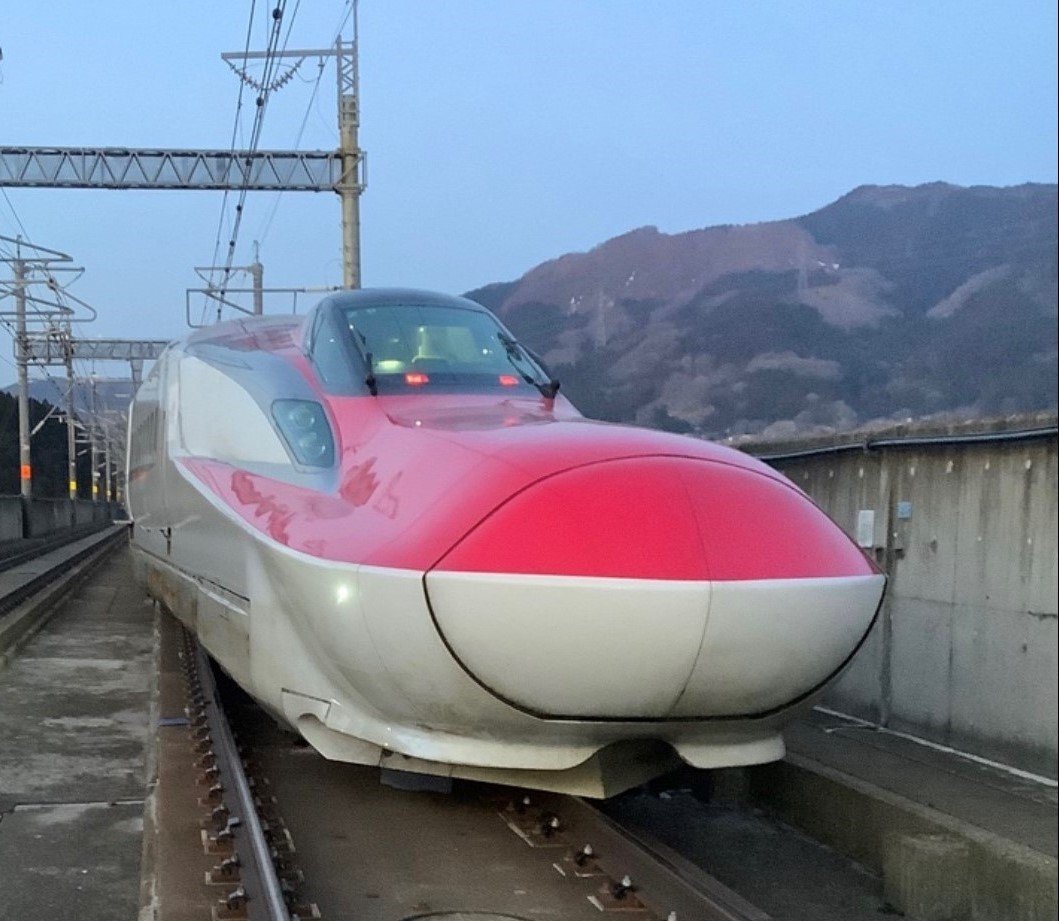On April 14, 2022, the Tohoku Shinkansen, which suspended operation due to damage caused by a major earthquake the previous month, resumed operation on all lines. In addition to derailing rolling stock, the earthquake also damaged many ground facilities. Despite substantial losses, operational recovery was achieved in just a month, which was shorter than initially estimated. The quick recovery owed greatly to the efforts of the staff involved in the restoration work, the cooperation of JRTT and the JR companies as well as the various countermeasures that were taken prior to the earthquake based on past lessons learned.
During the night on March 16th, an earthquake of Magnitude 7.3 hit offshore of Fukushima Prefecture in the northeastern part of Japan. At that time, the Tohoku Shinkansen “Yamabiko 223”, which was running between Fukushima and Shiroishizao stations, stopped in response to the earthquake. Later inspection revealed damage to about 1,000 facilities over the entire Tohoku Shinkansen line, including derailment of 16 out of 17 cars of one train set (the maximum length of each derailment was about 1,000mm), damage to civil structures, destruction of power poles, orbital displacement, and damage to station facilities. Fortunately, and most importantly, all passengers’ lives on board were saved as a result of earthquake countermeasures taken prior to this incident.
As Japan is an earthquake-prone country, train operators have taken various safety measures to prevent injuries and damage due to earthquakes. Japan’s first derailment of an operating Shinkansen was caused by the Niigata-Chuetsu earthquake in 2004. Since that incident, Shinkansen operators have been working to strengthen measures to prevent the derailment of Shinkansen trains.
For example, JR East introduced its “Shinkansen Early Earthquake Detection System,” which detects earthquakes early on using seismometers installed along its routes and in coastal and inland locations. Shinkansen operation is stopped immediately when the seismometers detect the primary wave of an earthquake. Since 2005, JR East has increased the number of seismometers along its lines and improved its estimating methods to try to stop train service as soon as possible in the event of an earthquake. Over the years, the company has worked to further improve its detection system and has established an early earthquake detection process utilizing data from ocean bottom seismometers. Since 2017, information from these seabed seismographs has also been integrated into the company’s “Shinkansen Early Earthquake Detection System”.
Along with measures to stop train operation immediately in the event of an earthquake, JR East has also focused on seismic infrastructure reinforcement measures and methods to prevent train deviations from lines. Since the Great Hanshin-Awaji earthquake in 1995, JR East has placed a great amount of effort on the prevention of bridge-collapse, reinforcement of viaducts and fortifying bridge girders. The company had reinforced elevated bridge columns which susceptible to shear failure for the entire Shinkansen lines by the end of FY2008, and since that time it has worked continuously to implement various reinforcements to improve safety. However, depending on the magnitude of the earthquake and other factors, it may be difficult to completely prevent a derailment. Therefore, in order to minimize damage in the case of derailment, JR East equipped Shinkansen bogies with deviation prevention guides based on lessons learned from the Niigata Chuetsu Earthquake. On the ground side, the shape of the glued insulated joints has been improved to reduce the impact of wheels and bogie parts in the event of a derailment. Additionally, rail fall prevention devices have been installed guide the wheels along the rails following a derailment, thereby preventing a rail fall and the rails from completely deviating from the track even after a train derails and the rail fasteners are broken. JR East is not the only company in Japan that has introduced measures against deviation and derailment of Shinkansen. Operators of the Tokaido Shinkansen and Kyushu Shinkansen have also developed “Derailment Prevention Guards” that avoid derailments as much as possible.
When it comes to disaster countermeasures, “hard” measures, such as the installation of physical equipment to prevent derailments, tend to be the focus, however, “soft” measures are also extremely important. In order to improve the preparedness skills of each employee, in addition to training on normal daily procedures, railway companies conduct disaster prevention training during which they anticipate and train for irregular situations. Further, on a daily basis they confirm procedures related to the initial response in case of emergencies, the evacuation of passengers, and measures for those who have difficulty returning to their homes due to an emergency.
As mentioned above, through both hard and soft measures, even in the case of a recent major earthquake which resulted in a derailment, damage was minimized. Also, even while the Tohoku Shinkansen was suspended, the train operator fulfilled its mission as a public transportation enterprise to facilitate the movement of passengers by transferring them to another means of transport such as a parallel local line that was restored at an early stage.
There are still many lessons to be learned from the Tohoku Shinkansen’s recent derailment, and a survey is currently being conducted to further investigate this incident. The knowledge gained will surely be used for future safety improvements. As always, Japanese High-speed Rail operators will continue their efforts to ensure safe operations of the Shinkansen in order to fulfill their missions to protect the lives of passengers.
References URL
https://www.engineer.or.jp/c_cmt/rinri/topics/008/attached/attach_8249_1.pdf
https://toyokeizai.net/articles/-/115150?page=3
https://www.jreast.co.jp/press/2005_2/20051020/no_3.html
https://www.jreast.co.jp/eco/report/pdf_2012/p56.pdf
https://www.mlit.go.jp/tetudo/content/001446503.pdf
https://faq.jr-central.co.jp/detail/faq000097.html
https://www.jreast.co.jp/press/2020/20210303_ho01.pdf
https://company.jr-central.co.jp/others/report/_pdf/report2021-05.pdf
